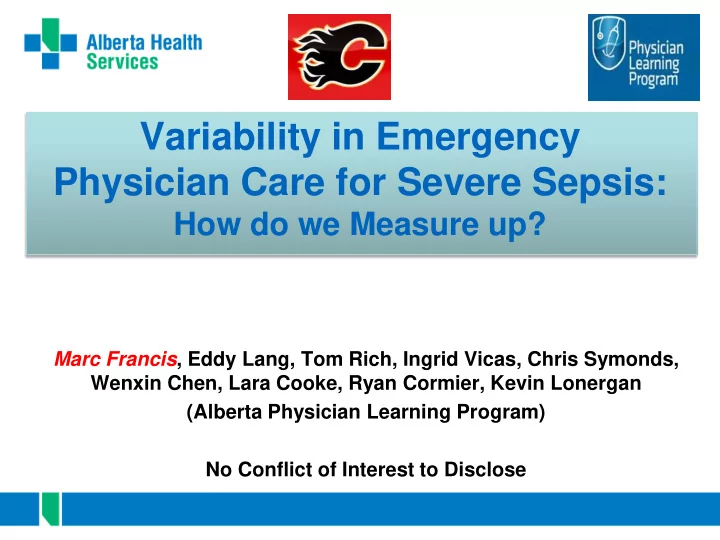

Variability in Emergency Physician Care for Severe Sepsis: How do we Measure up? Marc Francis , Eddy Lang, Tom Rich, Ingrid Vicas, Chris Symonds, Wenxin Chen, Lara Cooke, Ryan Cormier, Kevin Lonergan (Alberta Physician Learning Program) No Conflict of Interest to Disclose
2
Outline • Background • Objective of the Study • Methods • Results • Limitations • Conclusions 3
Background 4
Severe Sepsis 5
Time - Dependent Surviving Sepsis Campaign Guidelines 2013 “Administration of effective intravenous antimicrobials within the first hour of recognition of septic shock (grade 1B) and severe sepsis without septic shock (grade 1C) as the goal of therapy” 6
Mortality with delays Predicted hospital mortality and 95% CI’s for time to first antibiotic administration in severe sepsis and septic shock Ferrer et al Critical Care Med 2014 Aug;42(8) 7
Objectives 8
Objective To explore emergency physician variation on key performance metrics in sepsis care using administrative data as a prelude to generating aggregate and individual physician-specific reports 9
Methods 10
Identification of Severe Sepsis • All the patient visits included in the study cohort were selected based on the below criteria: 1) Patient age >18yo 2) Had a lactate ordered in the ED and the initial result was ≥ 2.0 mmol/L 3) Had an infection-related primary admitting ICD- 10 code 4) Had antibiotics ordered while in the ED 11
Data Retrieval Sources Facilities Included • REDIS (Emergency Department • FMC Information System) • PLC • SCM (Sunrise Clinical Manager) • RGH • SHC (1-year data only) Time Period • 36 months total • January 1 - December 31 – 2011 – 2012 – 2013 12
Time Points 13
Statistics • Simple descriptive statistics • Median times were used for all time points – Non-normally distributed data – Avoid the impact of outliers • Interquartile range (IQR) was used to demonstrate statistical dispersion 14
Results 15
Aggregate Report • 2197 severe sepsis patient visits • Care provided by 146 different emergency physicians 16
Source of Sepsis Description A419 Sepsis, unspecified J189 Pneumonia unspecified N390 Urinary tract infection, unspecified J440 COPD with acute lower respiratory infection J690 Pneumonitis due to food or vomit L0311 Cellulitis of lower limb T814 Infection following a procedure R509 Fever unspecified 17
Time From Triage to Ordering of Serum Lactate Median Time from Triage to Ordering of a Serum Lactate Cohort Lower Quartile = 38 mins Cohort Upper Quartile = 151 mins Cohort median = 72 mins 80 70 450 patients (20%) with 60 delay >3hrs 50 # of Visits 40 30 20 10 0 0 60 120 180 240 300 360 Median time for each individual ED docs (minutes) 18
Median Time from Meeting Criteria for Severe Sepsis to Antibiotic Administration Median Time from Meeting Criteria for Severe Sepsis to Antibiotic Administration Cohort Lower Quartile = 7 mins Cohort median = 41 mins Cohort Upper Quartile = 101 mins 80 70 441 patients (20%) with 60 delay >2hrs 50 # of Visits 40 30 20 10 0 -120 -60 0 60 120 180 Median time for each individual ED docs (minutes) 19
Time from Meeting Criteria for Severe Sepsis to First Antibiotics Requested (discrete visits) 2 -18 -12 -6 0 6 12 18 Antibiotic Order Precedes Lactate Result 1 hour Time fro 20
Limitations 21
Limitations • Our definition of severe sepsis could be called into question • Unable to differentiate patients with severe sepsis from those with septic shock • No way of assessing appropriateness of antibiotic therapy • Did not assess patient outcome or mortality 22
Conclusions 23
Conclusions • ED Physicians demonstrate significant variation in practice of severe sepsis management in the ED • This variation has the potential to affect patient care • Time to antibiotics and other markers of quality sepsis care can be defined by administrative data and reported back to physicians 24
Questions? 25
Extra Slides
27
28
Blood Cultures Ordered 29
Serial Lactate Assessments 30
Surviving Sepsis Campaign Update 2015 • To be completed within 3hrs of time of presentation – Measure serum lactate – Obtain blood cultures prior to antibiotics – Administer broad spectrum antibiotics – Administer 30ml/kg crystalloid for hypotension or lactate ≥4mmol/L • To be completed within 6hrs of time of presentation – Vasopressors for persistent hypotension – Re-measure lactate if initial was elevated 31
Why Lactate? 32
• Single centre cohort study • N = 830 adults with severe sepsis in the ED • Tested for association between initial serum lactate level and mortality • Low (<2mmol/L) • Intermediate (2-4mmol/L) • High (>4mmol/L) 33
34
Recommend
More recommend